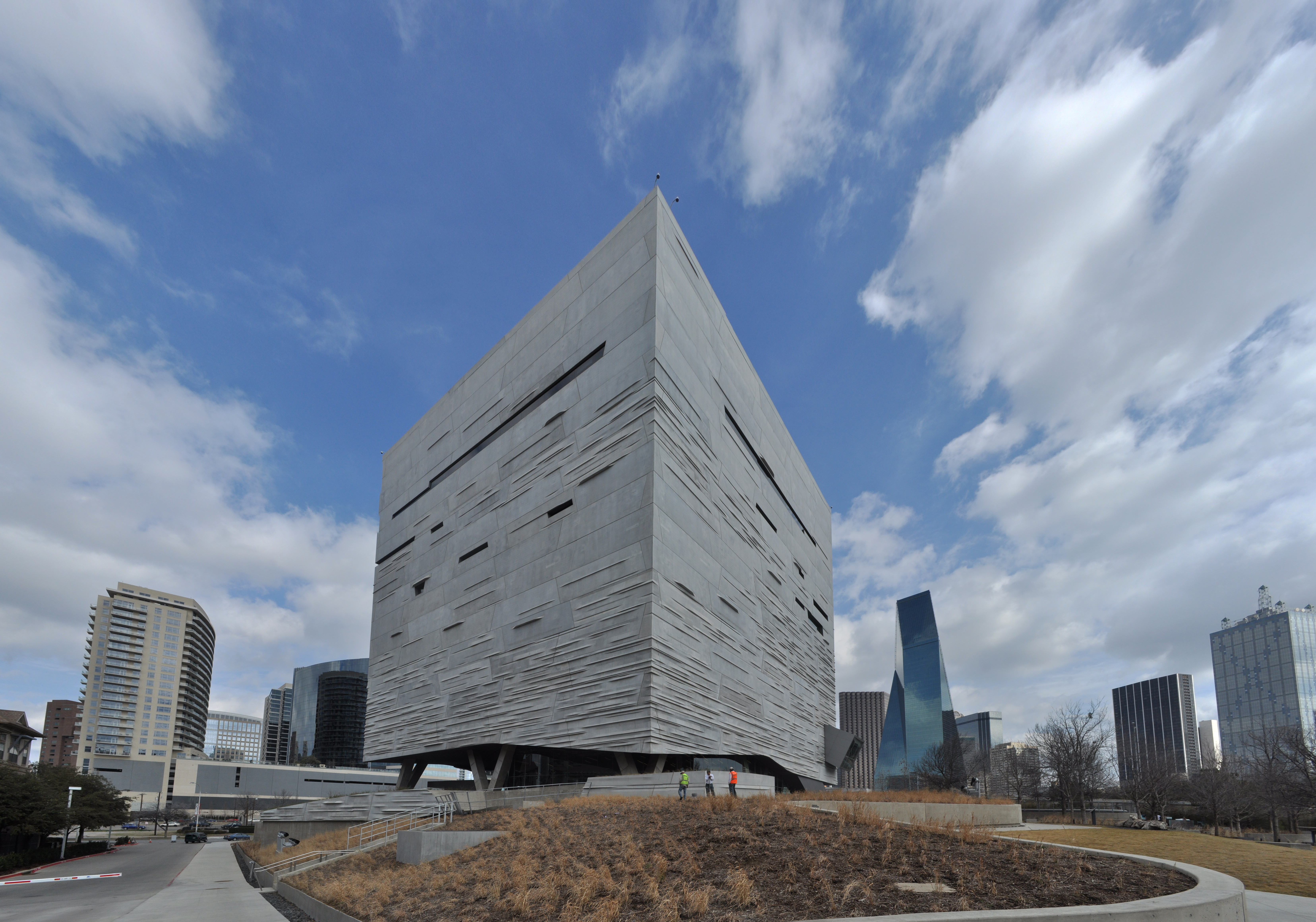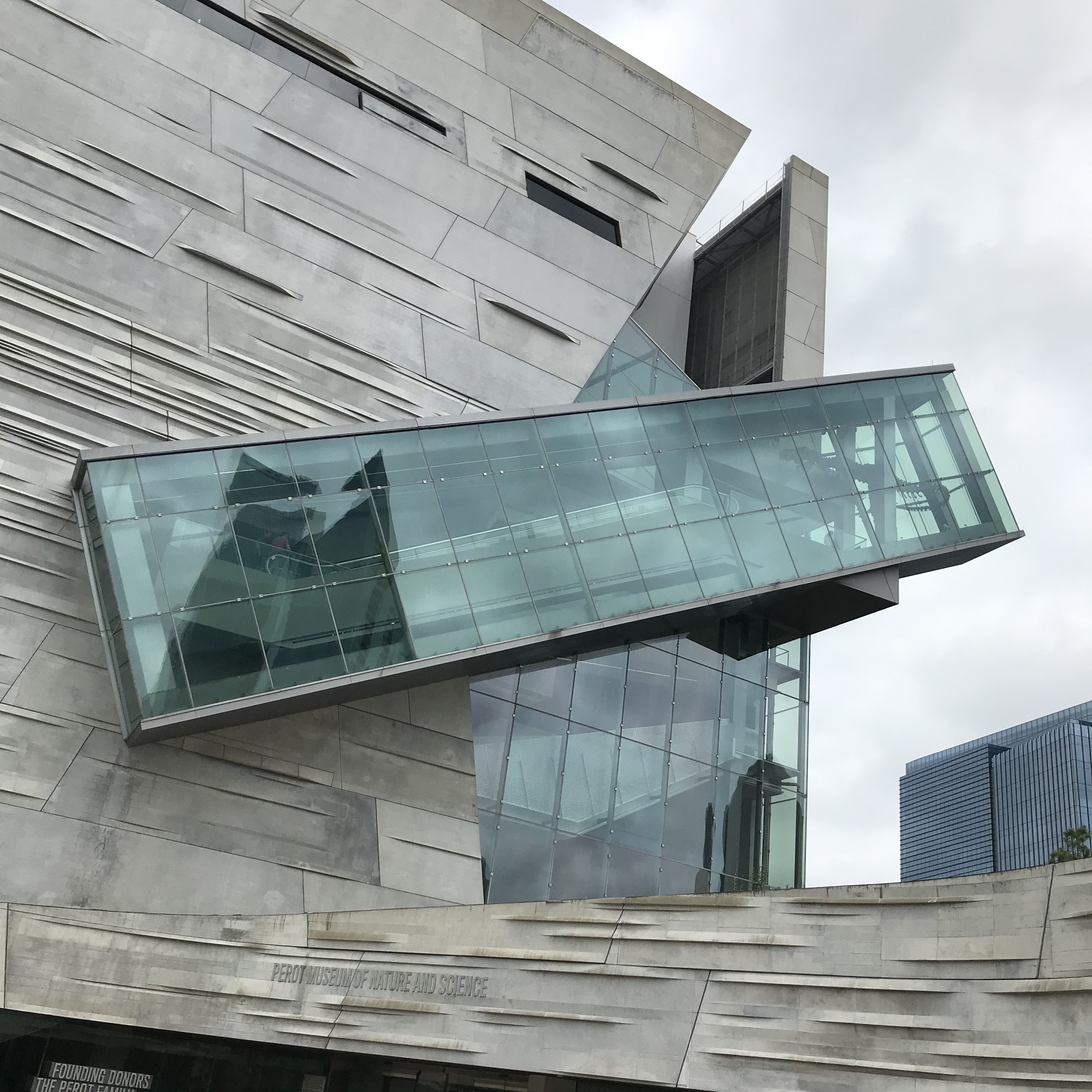Perot Museum of Nature and Science on:
[Wikipedia]
[Google]
[Amazon]
The Perot Museum of Nature and Science (shortened to Perot Museum) is a natural history and

 In 2006, Perot Museum CEO Nicole Small oversaw the uniting of the Dallas Museum of Natural History, the Science Place, and the Dallas Children's Museum at Fair Park. Following the merger, the museum was located in three buildings there, featuring an
In 2006, Perot Museum CEO Nicole Small oversaw the uniting of the Dallas Museum of Natural History, the Science Place, and the Dallas Children's Museum at Fair Park. Following the merger, the museum was located in three buildings there, featuring an
Official Web site of Perot Museum of Nature and ScienceDallas' Perot Museum designed to fit with Texas-specific public school curriculum Perot Museum - Sports Run Exhibit
{{DEFAULTSORT:Perot Museum Of Nature and Science Fair Park Museums in Dallas Science museums in Texas Children's museums in Texas Natural history museums in Texas Paleontology in Texas
The Perot Museum of Nature and Science (shortened to Perot Museum) is a natural history and
science museum
A science museum is a museum devoted primarily to science. Older science museums tended to concentrate on static displays of objects related to natural history, paleontology, geology, industry and industrial machinery, etc. Modern trends in mu ...
located in Dallas, Texas
Dallas () is the third largest city in Texas and the largest city in the Dallas–Fort Worth metroplex, the fourth-largest metropolitan area in the United States at 7.5 million people. It is the largest city in and seat of Dallas County w ...
in Victory Park. The museum was named in honor of Margot and Ross Perot
Henry Ross Perot (; June 27, 1930 – July 9, 2019) was an American business magnate, billionaire, politician and philanthropist. He was the founder and chief executive officer of Electronic Data Systems and Perot Systems. He ran an inde ...
. The current chief executive officer
A chief executive officer (CEO), also known as a central executive officer (CEO), chief administrator officer (CAO) or just chief executive (CE), is one of a number of corporate executives charged with the management of an organization especially ...
of the museum is Dr. Linda Abraham-Silver.
Background

History
On June 6, 1936, the Dallas Museum of Natural History opened to the public as part of the 1936 Texas Centennial Exhibition. On September 20, 1946, the Dallas Health Museum was founded by a group chartered as the Dallas Academy of Medicine. It was renamed the Dallas Health and Science Museum in 1958. The name was changed yet again to the Science Place in 1981. In 1995, the Dallas Children's Museum was founded elsewhere. In 2006, Perot Museum CEO Nicole Small oversaw the uniting of the Dallas Museum of Natural History, the Science Place, and the Dallas Children's Museum at Fair Park. Following the merger, the museum was located in three buildings there, featuring an
In 2006, Perot Museum CEO Nicole Small oversaw the uniting of the Dallas Museum of Natural History, the Science Place, and the Dallas Children's Museum at Fair Park. Following the merger, the museum was located in three buildings there, featuring an IMAX
IMAX is a proprietary system of high-resolution cameras, film formats, film projectors, and theaters known for having very large screens with a tall aspect ratio (approximately either 1.43:1 or 1.90:1) and steep stadium seating.
Graeme F ...
-style theater, a planetarium, an extensive exhibit hall, and its own paleontology lab. The museum relocated on December 1, 2012, to a new facility in Victory Park.
On June 1, 2014, CEO Small was replaced by Colleen Walker.
Walker resigned as CEO in 2017, and was replaced in 2017 by Linda Abraham-Silver.
Donation and endowment
The Victory Park campus museum was named in honor of Margot andRoss Perot
Henry Ross Perot (; June 27, 1930 – July 9, 2019) was an American business magnate, billionaire, politician and philanthropist. He was the founder and chief executive officer of Electronic Data Systems and Perot Systems. He ran an inde ...
as the result of a $50,000,000 gift made by their adult children Ross Perot, Jr., Nancy Perot Mulford, Suzanne Perot McGee, Carolyn Perot Rathjen, and Katherine Perot Reeves. The $185,000,000 fundraising goal, slated to provide for the site acquisition, exhibition planning and design, construction of the new building, education programs and an endowment, was achieved by November 2011, more than a year before the museum's scheduled opening in December 2012. The donated funds enabled the museum to be built without incurring any debt or public funding.
Victory Park campus
The 180,000 square foot facility has six floors and stands about 14 stories high. Five of the floors are accessible to the public and house 11 permanent exhibit halls as well as 6 learning labs. The top floor houses the museum's administration offices. The Victory Park campus opened its doors to the public on December 1, 2012. Approximately 6,000 visitors came to the museum on its first day of operation.Building design
Designed byThom Mayne
Thom Mayne (born January 19, 1944) is an American architect. He is based in Los Angeles. In 1972, Mayne helped found the Southern California Institute of Architecture (SCI-Arc), where he is a trustee and the coordinator of the Design of Cities p ...
of Morphosis Architects
Morphosis Architects is an interdisciplinary architectural and design practice based in Los Angeles and New York City.
History
The firm was informally founded in 1972 by Michael Brickler, Thom Mayne, Livio Santini and James Stafford. Michael Rot ...
, the building was conceived as a large cube floating over a landscaped plinth
A pedestal (from French ''piédestal'', Italian ''piedistallo'' 'foot of a stall') or plinth is a support at the bottom of a statue, vase, column, or certain altars. Smaller pedestals, especially if round in shape, may be called socles. In c ...
(or base).
The stone roof, which features a landscape of drought-tolerant greenery, was inspired by Dallas surroundings. The plinth was landscaped with a 1-acre rolling green roof
A green roof or living roof is a roof of a building that is partially or completely covered with vegetation and a growing medium, planted over a waterproofing membrane. It may also include additional layers such as a root barrier and drainage ...
consisting of rock and native drought-resistant grasses that reflects Texas' indigenous landscape and demonstrates a living system that will evolve naturally over time. Building on the museum's commitment to resource conservation, the new building has a rainwater collection system that captures run-off water from the roof and parking lot, satisfying 74% of the museum's non-potable water needs and 100% of its irrigation needs.
The building features a continuous flow escalator housed within a glass casing that extends diagonally outside the building cube. To maximize sustainability, the building also features LED lighting, off-grid energy generation technology and solar-powered water heating. Skylights draw natural sunlight into the atrium and to the other spaces.
The building has secured the highest possible 4 Green Globes from the Green Building Initiative. It obtained a rating of an overall 85% on the Green Globes rating scale and 100% for its design and its sustainable performance measures. Green Globes is a nationally recognized green building guidance and assessment program in the United States.
Permanent exhibit halls
Temporary exhibit halls
The Hoglund Foundation Theater A National Geographic Experience
The 297-seatAmericans with Disabilities Act
The Americans with Disabilities Act of 1990 or ADA () is a civil rights law that prohibits discrimination based on disability. It affords similar protections against discrimination to Americans with disabilities as the Civil Rights Act of 1964 ...
(ADA) compliant theater has a 2D, 3D 4K digital projection and sound system. The theater features a variety of films from educational features and documentaries to experimental independent films.
Educational outreach
The museum creates a Teacher's Guide, which is a booklet and online publication that is distributed to North Texas educators. The guide outlines programming designed for children pre-K to 12th grade in earth and space sciences, life and natural sciences, chemistry, physical sciences and engineering. Programming is designed to reinforceTexas Essential Knowledge and Skills
Texas Essential Knowledge and Skills or TEKS are the state standards for Texas public schools from kindergarten to year 12. They detail the curriculum requirements for every course. State-mandated standardized tests measure acquisition of specific ...
(TEKS) objectives.
There are four educational outreach opportunities: field trips to the museum, onsite programming at schools (in the classroom and after school), Community Engagement through the Museum's TECH Truck and The Whynauts virtual, bilingual video series.
Field trips
Students can explore 11 permanent exhibit halls, experience educational films in their theater, and take advantage of TEKS-aligned onsite classroom or auditorium programming. Further learning, available through program extensions, is held in the learning labs and auditorium of the museum's Lower Level. The museum also features educational films, offered in partnership with National Geographic.Onsite programming at schools
Museum educators offer 26 programs that can be taught in schools’ classrooms, presented to large groups in auditoriums, or showcased as part of after-school programming.Community Engagement
The TECH Truck brings hands-on discovery directly to community centers programs, libraries, parks, public events, out-of-school programs and more — providing science-based experiences for the public.The Whynauts
Bring the wonders of the Perot Museum to your classroom through an interactive, bilingual, STEM educational series.See also
* List of nature centers in Texas * List of museums in North Texas *Heard Natural Science Museum and Wildlife Sanctuary
A private 501(c)3 nonprofit organization founded in 1967, the Heard Natural Science Museum & Wildlife Sanctuary is located in McKinney, Texas, United States. With a 289-acre wildlife sanctuary, five miles of hiking trails, about fifty acres of wet ...
* Fort Worth Museum of Science and History
*National Register of Historic Places listings in Dallas County, Texas
This is a list of the National Register of Historic Places listings in Dallas County, Texas.
This is intended to be a complete list of properties and districts listed on the National Register of Historic Places in Dallas County, Texas. There are ...
*List of Dallas Landmarks
Dallas Landmark is a designation by the City of Dallas and the Dallas Landmark Commission for historic buildings and districts in Dallas, Texas, United States. Listed sites are selected after meeting a combination of criteria, including historica ...
References
External links
Official Web site of Perot Museum of Nature and Science
{{DEFAULTSORT:Perot Museum Of Nature and Science Fair Park Museums in Dallas Science museums in Texas Children's museums in Texas Natural history museums in Texas Paleontology in Texas